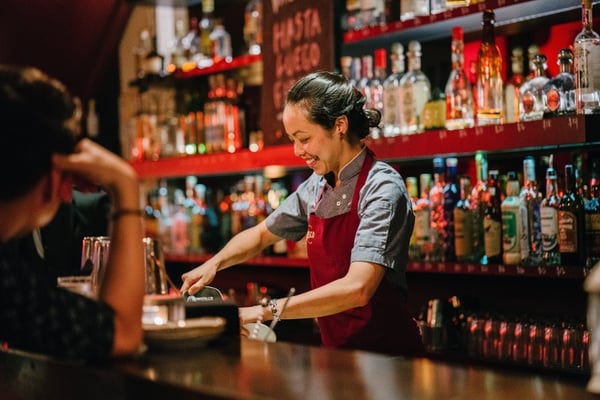If you hang out in bars long enough, you'll eventually start to hear all sorts of unusual and interesting phrases being thrown around. Each bar will have its own unique vernacular, but many terms are commonly used throughout the industry. Here's a guide to the bar lingo you should know to become a bartending pro.
Bar Lingo
- Bar Spoon: A long-handled spoon intended for mixing and laying drinks. It's length ensures it can reach the bottom of a tall tumbler or jug to mix ingredients in the glass.
- Bitters: An herbal alcoholic blend that is used as an additive in cocktails to enhance flavor.
- Behind the stick: A slang term for the actual act of getting behind the bar and doing the work of bartending. Whenever you work, you are 'behind the stick'.
- Blend: To mix up ice and ingredients in an electric blender.
- Bruised: When a cocktail or martini has be over shaken and pieces of ice and oxygen bubble forms. This results in a cloudy or murky looking cocktail.
- Building a drink: A bar term meaning to make a drink. To build a drink, you add ice to a glass and then add the spirit and mixers.
- Chaser: A chaser is the delicious drink you get to take following the gross one you just took a shot of. You can pretty much use anything to chase anything, let that be a lesson and a warning.
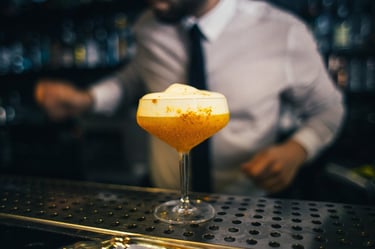
- Cocktail: An alcoholic drink consisting of one or multiple liqueurs combined with a mixer, such as fruit juice, soda, cream, etc.
- Cooler: An alcoholic-based beverage, offered in a variety of different alcohols and flavors. (E.g. Mike's Hard Lemonade, Seagram's Escapes, Smirnoff Ice).
- Dirty: Adding olive juice to a martini, making it a Dirty Martini. The more olive juice there is, the dirtier the martini.
- Dry: Less Vermouth added to a martini. An extra dry martini is a drop of scotch swirled around the martini glass and poured out before the gin is added or no vermouth added at all.
- Finger: A unit of measurement when pouring spirits. Varies and is literally the size of the bartenders finger.
Fun Fact!
While this term is no longer used often because of the inconsistency in bartenders finger size's, it was a very popular term in Old Western American Saloons! So if you ever want to show off your bartender knowledge this term is the perfect way to do so.
- Free Pour: Making and mixing drinks without using a measuring device.
- Frost: To frost a glass, dip it in water, let it drain and stick it in the freezer. This works especially well for beer mugs, because it creates a layer of frost around the glass that will keep the drink cold longer.
- Garnish: Something added to a drink after it is made to enhance the presentation. Common garnishes include cherries, lemon slices, lime wedges, cucumber slices, olives, etc. Sometimes garnishes are intended to add flavor to the drink, other time they're purely for appearance.
- Highball: Served in a tall glass, a highball is any liquor mixed with soda.
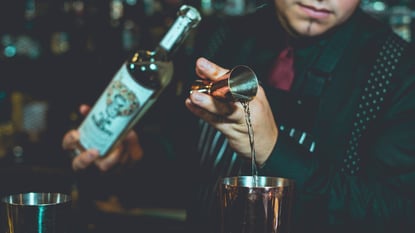
- Jigger: The hour-glass shaped measuring device. The larger end measure out 1 ½ ounces and the smaller end measures out ¾ of an ounce. (pictured on the right)
- Last Call: The last opportunity to buy drinks before the bar is closed for the night.
- Mist: Liquor served over a glass filled with crushed ice
- Muddle: To crush up ingredients with a tool called a muddler.
- Neat: For a drink made without a mixer or ice, you'd order it "neat". Neat means straight from the bottle, no ice.
- On the Rocks: Customers may think they've outsmarted the bartender into giving them more alcohol, but it is important to know that this order will get you a standard pour (often 1.25, 1.5, or 2oz) of straight spirit served over ice.
Fun Fact!
Ever wondered where this phrase came from? Well many may tell the story differently, but it was actually just a phrase coined in the 1940's simply to describe ice because it was often hard like a rock!
- Pony: A pony shot is equal to 1 oz.
- Premium: Premium refers to top shelf liquor (top shelf for your best self!).
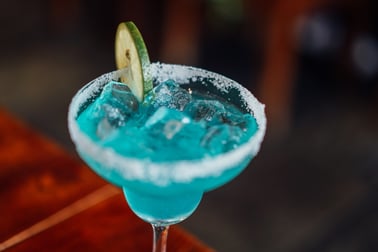
- Rim: To rim a glass, wet the rim with a lime or lime juice in a rimmer, then press the rim of the glass into a saucer of your choice of salt or sugar (salt for Margaritas and Bloody Marys, sugar for coffees and cocktails).
- Rinse: To “rinse” a glass is to take a small amount of liquor and swirl it around the glass creating a light coating. This helps bring out some of the flavors of the drink.
- Rolling a Drink: Another mixing method where a drink is put together in one mixer then slowly poured into another mixer. It is a more delicate way to mix drinks that can’t be shaken or stirred.
- Shrub: A mix of a vinegar based syrup mixed with a spirit to create a cocktail or mixed drink.
- Sour: 'Sour' refers to the sourness of the sour bar mix/lime bar mix/margarita mix which are used in cocktails.
- Speed Rack : A rack placed directly behind the bar and in front of bartenders. It usually holds the most common liquors and ingredients one would need to create a drink.
- Stiff: Had a long day? Need a stiff drink? A drink made stronger than normal.Can mean a drink served without mixer or a drink that has more liquor than mixer.
- Straight Up: This refers to a drink that has been shaken in a shaker and strained into a glass.
- Thin: A drink that has been watered down. Can be done by too much ice or not
.jpg?width=383&name=alcohol-bar-beer-1283219%20(1).jpg) enough liquor.
enough liquor.
- Top Shelf : Similar to Premium, they’re the most expensive bottles of alcohol and considered the best
- Twist: A twist is the rind of a lemon that has been peeled with a special peeler called a zester. The lemon twist is long and thin and can be used to garnish martinis.
- Up: A drink served up has been chilled by shaking or stirring, and then strained out into a chilled, stemware cocktail glass without ice.
- Virgin: This refers to a non-alcoholic drinks. You can use this to order common cocktails minus the alcohol. (E.g. Virgin Mojito, Virgin Pina Colada).
- Well Drink: An alcoholic beverage served using the lower-cost liquors. A well drink is a drink where neither the brand of the liquor or brand of the mix is mentioned (E.g. Vodka Cranberry, Rum & Coke).
- Wet: A term used when ordering a martini. This means that you want more vermouth added to a martini than normal.
- 86 : In the food service industry, "86" is a slang term that is used to indicate that an item is no longer available on the menu.
Knowing the Difference
Nothing screams more amateur than confusing common bar terms. Using the wrong term can completely change the way a drink taste and how it is made. To avoid looking like an amateur, we have complied some of the most commonly confused bar terms.
Neat vs. Straight Up vs. Up
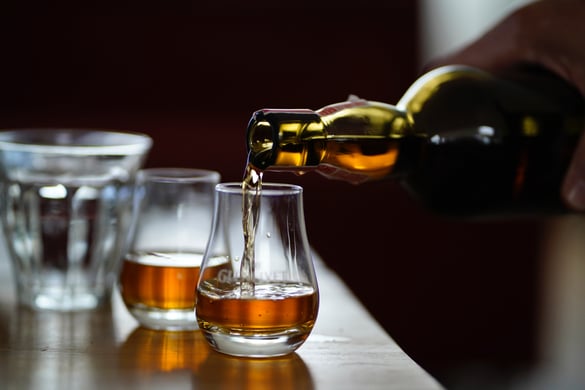
Neat, Straight Up , and Up are all common ways to serve a drink and even patrons will commonly confuse the terms when ordering. Sometimes it will require clarification.
Below we have listed the the definitions to demonstrate how the terms are similar yet small details make them very different.
Neat: For a drink made without a mixer or ice, you'd order it "neat". Neat means straight from the bottle, no ice.
Straight Up: This refers to a drink that has been shaken in a shaker and strained into a glass.
Up: A drink served up has been chilled by shaking or stirring, and then strained out into a chilled, stemware cocktail glass without ice.
While all three methods produce a drink without ice, a neat drink is going to be room temperature, a straight up drink will be chilled from being shaken or stired with ice, and an up drink will be served cold because of a chilled glass.
On the Rocks vs. Frost vs. Mist
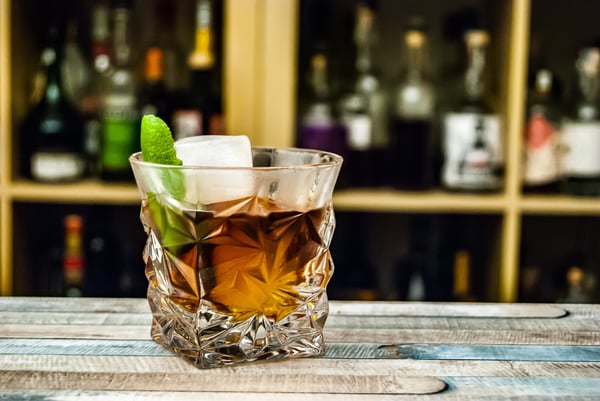
Ice is a major factor considered when making a drink all with the goal of chilling the drink without making it watered down. The perfect clear ice(takes longer to melt) served with your favorite spirit is the perfect way to experience a drink on the rocks. On the other hand ordering a beer frosted wont get you a glass with ice but a glass dipped in water and chilled and the freezer. Lastly, a misty cocktail is one served over crushed ice.
On the Rocks: Customers may think they've outsmarted the bartender into giving them more alcohol, but it is important to know that this order will get you a standard pour (often 1.25, 1.5, or 2oz) of straight spirit served over ice.
Frost: To frost a glass, dip it in water, let it drain and stick it in the freezer. This works especially well for beer mugs, because it creates a layer of frost around the glass that will keep the drink cold longer.
Mist:Liquor served over a glass filled with crushed ice
Shaken vs Stirred
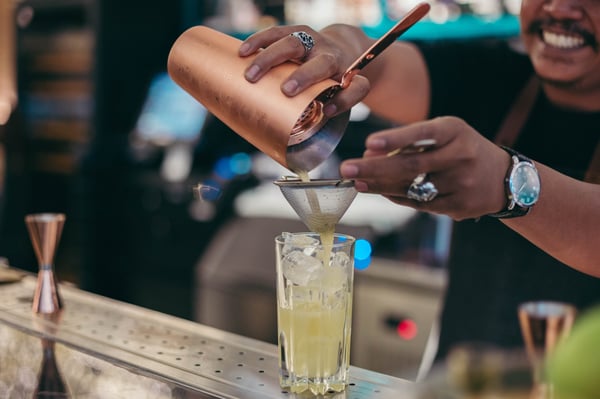
Shaken and stired are both very common ways to prepare a cocktail. While both methods can change how a drink taste, its important to understand the meaning of each term and how it impacts a drinks appearance and taste.
Shaken: a method for preparing a drink. The ingredients are placed into a shaker, shook up, the strained into a glass. This is commonly used for drinks for drinks like martinis and cocktails that contain any thick mixers or dairy.
WARNING: A drink can be overshaken. Since a shaken drink will case the ice to melt quicker, a drink over shaken can dilute the cocktail to quickly, lessening its taste
Stired: A more delicate method to prepare a cocktail that is used for drinks containing distilled spirits or light mixers. The preferred method for more delicate drinks such as manhattans.
With these basics to understanding the secret language of bartenders, you'll be navigating your next bar order like you've been behind the stick your whole life.
